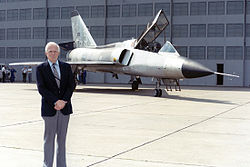Richard T. Whitcomb: Difference between revisions
No edit summary |
Mytwocents (talk | contribs) added pic |
||
| Line 5: | Line 5: | ||
==Career== |
==Career== |
||
[[Image:Richard Whitcomb Examines Model - GPN-2000-001262.jpg|thumb|left|150px|Richard Whitcomb Examines Model.]] |
|||
In the 1950s, Whitcomb proposed the '[[area rule|Area Rule]]'. The Area Rule states that two bodies having the same cross-sectional area distribution will have the same wave drag, as measured in the far field. As the axi-symmetric body with the minimum wave drag in transonic flow was shown to be the [[Sears-Haack body]], this provided an optimal distribution to compare designs with. The impact of this concept on aircraft design was immediate. The prototype [[F-102 Delta Dagger|Convair YF-102]] was found to not be capable of exceeding the speed of sound in level flight. By sculpting the fuselage, to reduce the fuselage cross-sectional area in the region of the wing, the aircraft's area distribution was made closer to optimum. The resulting aircraft was found to be capable of exceeding the [[speed of sound]] in level flight. For this discovery, Whitcomb won the [[Collier Trophy]] in 1954. |
In the 1950s, Whitcomb proposed the '[[area rule|Area Rule]]'. The Area Rule states that two bodies having the same cross-sectional area distribution will have the same wave drag, as measured in the far field. As the axi-symmetric body with the minimum wave drag in transonic flow was shown to be the [[Sears-Haack body]], this provided an optimal distribution to compare designs with. The impact of this concept on aircraft design was immediate. The prototype [[F-102 Delta Dagger|Convair YF-102]] was found to not be capable of exceeding the speed of sound in level flight. By sculpting the fuselage, to reduce the fuselage cross-sectional area in the region of the wing, the aircraft's area distribution was made closer to optimum. The resulting aircraft was found to be capable of exceeding the [[speed of sound]] in level flight. For this discovery, Whitcomb won the [[Collier Trophy]] in 1954. |
||
Revision as of 00:05, 8 September 2011

Richard T. Whitcomb (February 21, 1921 – October 13, 2009), was an American aeronautical engineer noted for his significant contributions to the science of aerodynamics.
Whitcomb was born in Evanston, Illinois but grew up in Worcester, Massachusetts and earned his bachelors degree at Worcester Polytechnic Institute. He spent most of his career at the Langley Research Center operated by National Advisory Committee for Aeronautics (NACA) and its successor, NASA.
Career

In the 1950s, Whitcomb proposed the 'Area Rule'. The Area Rule states that two bodies having the same cross-sectional area distribution will have the same wave drag, as measured in the far field. As the axi-symmetric body with the minimum wave drag in transonic flow was shown to be the Sears-Haack body, this provided an optimal distribution to compare designs with. The impact of this concept on aircraft design was immediate. The prototype Convair YF-102 was found to not be capable of exceeding the speed of sound in level flight. By sculpting the fuselage, to reduce the fuselage cross-sectional area in the region of the wing, the aircraft's area distribution was made closer to optimum. The resulting aircraft was found to be capable of exceeding the speed of sound in level flight. For this discovery, Whitcomb won the Collier Trophy in 1954.
In the 1960s, Whitcomb developed the supercritical airfoil, and in the 1970s, Whitcomb developed winglets, devices used at the wingtips, normal to the wingspar, extending both upward and downward, which reduce wingtip vortices and the induced drag such vortices create, improving the aerodynamic efficiency of the wing and seen frequently in modern airliners, in which they reduce fuel consumption, and in sailplanes in which they improve glide ratio.
Whitcomb died in Newport News, Virginia
Awards and honors
- USAF Exceptional Service Medal (1955)
- NACA Distinguished Service Medal (1956)
- ASA Exceptional Scientific Service Medal (1959)
- National Medal of Science in engineering. (1973)
- Wright Brothers Memorial Trophy of the National Aeronautic Association. (1974)
- member National Academy of Engineering (1976)
- Howard N. Potts Medal (1979)
- NAS Award in Aeronautical Engineering from the National Academy of Sciences. (2000)[1]
- National Inventors Hall of Fame (2003)
References
- ^ "J. C. Hunsaker Award in Aeronautical Engineering". National Academy of Sciences. Retrieved 14 February 2011.
External links
- T. Rees Shapiro (October 16, 2009). "Richard Whitcomb, 88, Dies; Engineer Changed the Way We Fly". The Washington Post Obituary. Retrieved May 22, 2010.
- "Whitcomb's First Clue". Engineer in Charge. NASA History Division. January 1986.
- "NASA People: Aviation Pioneer Richard T. Whitcomb". NASA Langley Research Center. October 13, 2009.
- American aerospace engineers
- Worcester Polytechnic Institute alumni
- NASA personnel
- Collier Trophy recipients
- People from Evanston, Illinois
- 1921 births
- 2009 deaths
- Aerospace engineers
- Fluid dynamicists
- Aerodynamicists
- National Medal of Science laureates
- National Inventors Hall of Fame inductees
- National Academy of Sciences laureates
- American engineer stubs
- Aviation stubs
